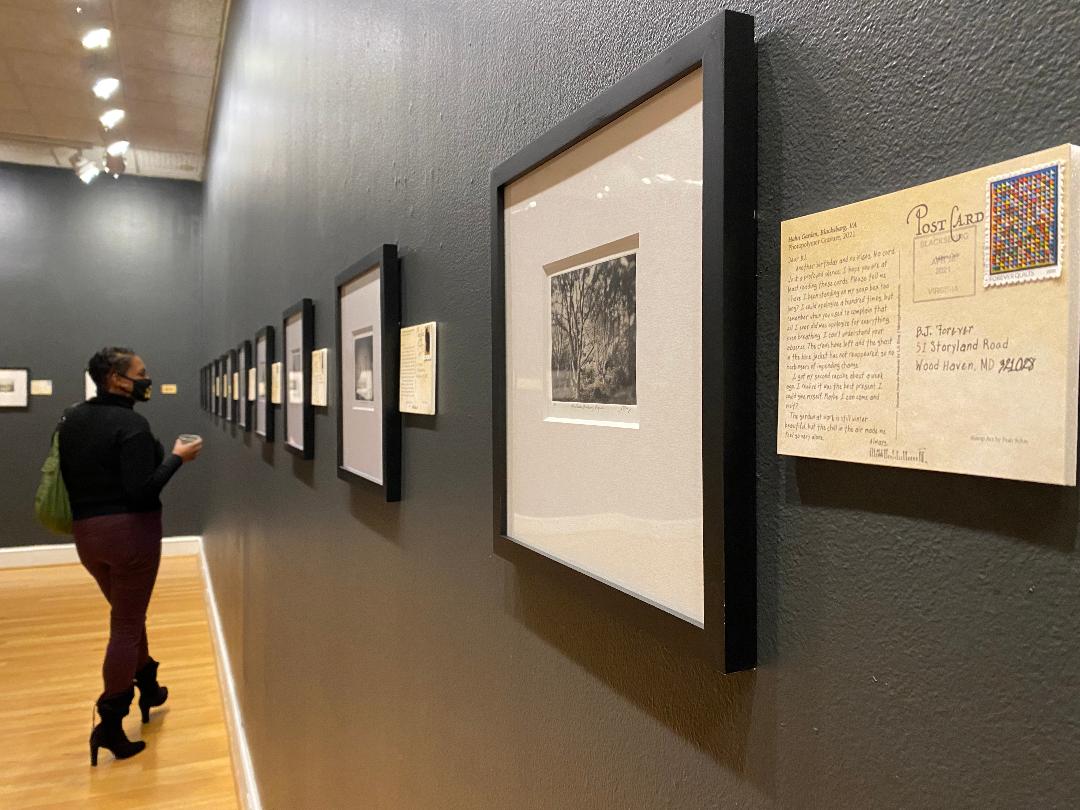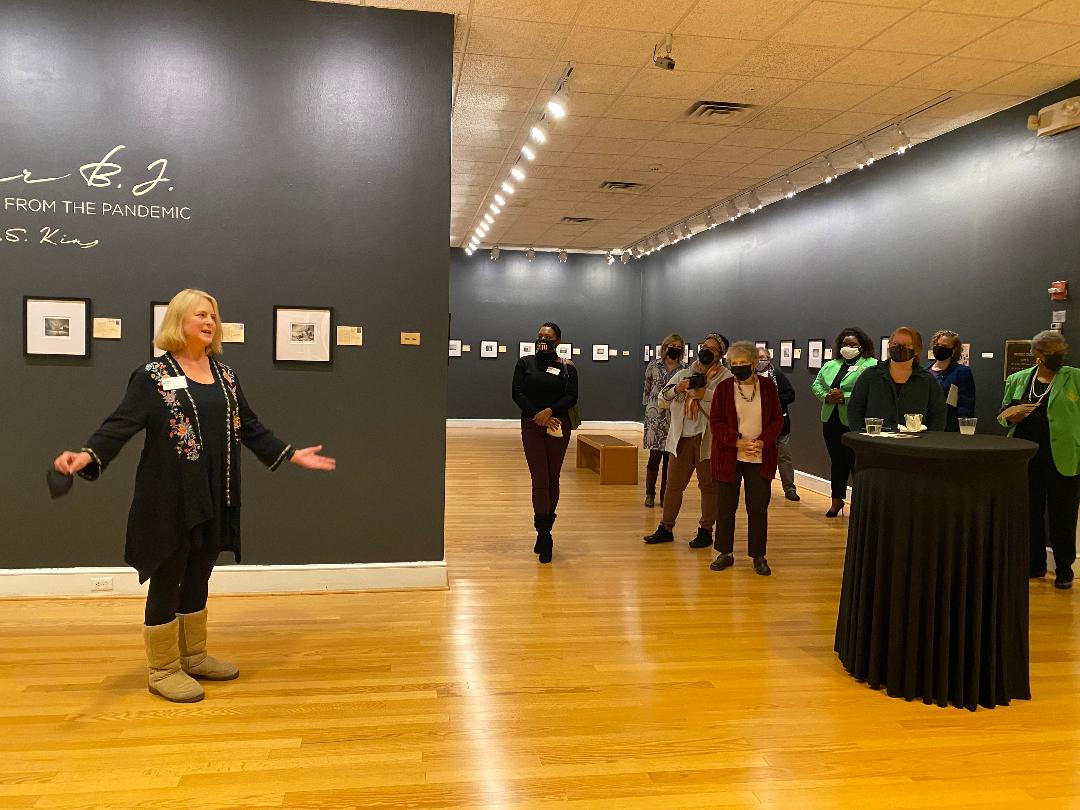By Callie Hietala
“It’s a special night for Piedmont Arts,” said Piedmont Arts Director Heidi Pinkston last Friday as she welcomed artists and art-lovers in the second level gallery space of the museum.
It was a special night indeed, as members of the community gathered not only to celebrate the opening of the museum’s three new exhibits but also to help kick off the public phase of the organization’s capital campaign.
“Our Living Past”
Photography Tim Duffy said he used tintype photography to capture the portraits seen in “Our Living Past” because it was the most American kind of photography, invented in the United States.
The exhibit features 25 platinum-printed portraits of southern musicians including Derek Trucks of the Allman Brothers Band, legendary blues musician Taj Mahal, gospel singer Lena Mae Perry, and bluesman and guitar-maker Freeman Vines.
“This is American history joined by 150 years of photography techniques,” said Pinkston.
“I’m an American artist focusing on our greatest American export, our music,” Duffy told a gathered crowd. “These artists represent who we are as Americans. Like all the music that came before, that’s enjoyed throughout the world to this day, (all those artists) drink from the south.”
Duffy and his wife, Denise, are co-founders of the Music Maker Foundation. Denise said that the organization “taps the roots of American music by directly supporting senior musicians. We help document their work, we help get their work out to the world, and we also have programs that help artists living in chronic poverty.”
She said that the foundation “works with the artists that we think are most important to American musical heritage and the most vulnerable,” including blues and gospel artists, Appalachian string band musicians, and even some zydeco musicians.
The organization’s work is concentrated in the southeastern U.S. because “we feel that in North Carolina, South Carolina, Virginia, and Georgia, we don’t get the cred that we deserve in American musical history,” she said, to applause from the audience.
“We’re still trying to come to realize and come to terms as a country with what happened here in the south,” Tim said. “All these people are veiled by poverty, race, and education, but that doesn’t mean they are not the most influential people amongst us.”
“Until we face it (what happened in the south) and celebrate these people and exalt them and make them seen . . . that’s the point of this exhibit, is to make people seen and heard and loved.”
“Dear B.J.: Postcards from the Pandemic”
“Dear B.J., two vaccines, one booster shot later, no words from you. I stand in front of a group of people I don’t actually know who know everything about you, know a little bit about me, and here we are. I implore you, write back. Always, me.”
Those were the words that opened L.S. King’s discussion about her exhibit which Pinkston described as a “creative non-fiction interpretation of life in Appalachia during the COVID-19 pandemic.”
The exhibit features black-and-white photographs, each accompanied by handwritten missives to someone identified only as “B.J.” and each signed by “ME.”
King said that, when the pandemic started, she found herself at home, walking around her neighborhood in Pulaski, VA, “and all I could see was beauty. I found beauty in decay, I found beauty in isolation.” So, she started taking photos.
King described herself as a photographer and a writer. “I also time travel,” she said, “and I have an obsession with the early 19th century.” She said she looked back at the Spanish influenza pandemic of 1918 and asked herself what her own heroes—photographers Ansel Adams, Alfred Stieglitz, and Lewis Hine—were doing at the time.
Adams, King said, discovered national parks, “discovered everything, became who he was.”
Stieglitz began creating nude photographs of his partner, future wife, and fellow artist Georgia O’Keefe, who contracted the flu and became emaciated which, King said, made her bone structure interesting.
King said that Hine, whose work previously focused on photographing children working in horrible conditions in factories, went to France to photograph people in hospitals.
“So, these are my heroes,” King said. “And I thought, ‘wow, they’re out there making art.’”
The text on the postcards, she said, came from her personal journals. “B.J. is real, I will tell you that. But I’m not going to tell you who B.J. is to me. Let that be a mystery. Let it be somebody you know.”
Opening her arms wide, King told the audience, “I invite you into my world.”
Tara Compton
Pinkston said Tara Compton returned home to Martinsville after spending time in New York City as an executive jewelry designer and fabricator.
“Tara’s work incorporates an element of realism while maintaining an abstract sensibility,” she said.
Compton told the crowd that she took up painting later in her career “and I’ve discovered it’s the most fun I’ve ever had.”
She said people often remark that each of her paintings look so different. That, she explained, is because she challenges herself to try something new whenever she begins a new work. “Every time I go to a painting I think ‘what have I not done yet?’” she said.
She said her works have a great deal of energy and emotion in them.
“I try to capture moments in time, that emotion of the moment,” Compton said of her inspiration. “When I’m painting, I’m not quite happy unless I’ve got some emotion in it.”
Growth + Restoration
A year and a half ago, Guy Stanley said he was busily pointing out various cosmetic and structural issues around the building during a meeting of Piedmont Arts’ board. Stanley, the first vice president of the board, told his fellow members that the museum needed a new roof, new paint, new railings. A foundation issue was causing the floor of the library to settle. There was an issue with the upper parking lot.
With the creation of a new fundraising campaign for improvements to the building, Stanley (who also serves as co-chair of the campaign’s committee) not only wanted to address the issues that were right in front of it. “We wanted to look to the future,” he said.
The future includes replacing both the interior and exterior lighting with energy-saving LED bulbs and installing solar panels, both of which will help lessen the museum’s expensive utility bill. Expanding event spaces will create more space to serve larger numbers of patrons. Renovations and revitalization of the building and grounds will help to ensure Piedmont Arts continued success in the community.
Stanley said that the goal for the Growth + Restoration campaign is $1 million, and the goal is already within sight. Prior to the public phase of the campaign, the committee had already raised over $750,000.
Stanley said the fundraising effort will be public for a year. “We are going to raise the money,” he said confidently. “We are going to get there.”
“Our Living Past: Platinum Portraits of Southern Music Makers,” “Dear B.J.: Postcards from the Pandemic,” and artwork by Martinsville native Tara Compton are all on display through March 12.
To make a donation to the museum’s Growth + Restoration campaign, click the Join + Give tab at www.piedmontarts.org.





